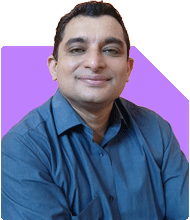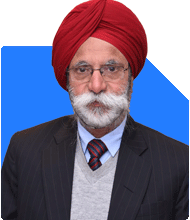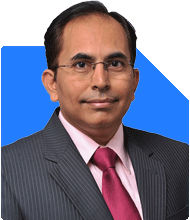Ramalingam Kalirajan |10901 Answers |Ask -Follow
Mutual Funds, Financial Planning Expert - Answered on Jun 04, 2025
He has an MBA in finance from the University of Madras and is a certified financial planner.
He is the director and chief financial planner at Holistic Investment, a Chennai-based firm that offers financial planning and wealth management advice.... more

Hello sir. I'm 60 years old, retired this year after 36 years of long service. I own a home worth 70 lakhs. I have 75 lakhs from my retirement corpus and I want a safe investment that gives me a monthly income of 45,000 to 50,000. I have no loans. I live in my own house, and have 10 lakhs in senior citizen savings scheme (SCSS). Should I opt for post office MIS + debt mutual funds, or invest in annuities or SWP-based mutual fund plans?
No loans, self-owned home, and Rs. 75 lakhs in hand means strong foundation.
Your aim is Rs. 45,000 to Rs. 50,000 monthly income, with safety.
Let us now look at a step-by-step, complete plan.
This plan will give safety, income, and peace of mind.
We will avoid annuities and real estate.
We will not recommend index funds or direct funds.
We will explain why mutual funds and SCSS with SWP are better.
Let’s begin.
Understanding Your Financial Goal
You need Rs. 45,000 to Rs. 50,000 monthly income.
That means Rs. 5.4 lakh to Rs. 6 lakh yearly income.
You want this income to be consistent, low-risk, and tax-efficient.
You have Rs. 75 lakhs retirement corpus + Rs. 10 lakhs in SCSS.
You live in your own house. No rent needed.
No loans. So, income needed only for regular living expenses.
Your Portfolio Should Be Built With These Goals:
Principal should remain safe.
Monthly income should be steady.
Tax should be minimum.
Liquidity should be available in case of emergency.
Portfolio should not be locked.
Money should grow slowly but steadily.
Let’s Evaluate Your Options
Let’s now examine your mentioned options.
We will pick only those that are best for your current life stage.
Post Office MIS (Monthly Income Scheme)
Good for safety and regular income.
Interest paid monthly. But interest is fixed, not growing.
Capital is protected. But returns don’t beat inflation.
Taxable as per slab. No special tax benefit.
Maximum Rs. 9 lakhs per person allowed.
Joint account can go up to Rs. 15 lakhs.
Can be one portion of the plan, not full.
SCSS (Senior Citizen Savings Scheme)
You already have Rs. 10 lakhs in SCSS.
That’s the maximum allowed per person.
Good choice. Gives quarterly interest payout.
Tenure is five years. Extendable by three years.
Interest rate is high. Fully taxable as per your slab.
Safe. Backed by government. Continue this.
Debt Mutual Funds + SWP
This option gives high flexibility.
You invest in debt mutual funds.
Then set up SWP (Systematic Withdrawal Plan) to get monthly income.
Your principal is invested. You only withdraw part monthly.
Returns are better than bank FD or post office.
Highly liquid. You can stop or change SWP anytime.
Fund value may fluctuate slightly, but risk is low in debt funds.
Returns are not fixed, but consistent if managed well.
Avoid direct funds. Choose regular funds via MFD + CFP.
Direct funds lack support. No advice, no planning.
Regular funds give complete service, handholding, and rebalancing.
You won’t panic when markets move if you go with CFP guidance.
SWP gives tax advantage. Only gain part is taxed.
Better tax than post office monthly schemes.
Why You Should Not Choose Annuities
Annuities give fixed income, but with poor returns.
They lock your capital permanently.
No access to money in emergencies.
No flexibility to increase or stop income.
You lose liquidity, control, and growth.
That’s why we never recommend annuities.
Recommended Portfolio for Safe and Growing Income
Now we structure your Rs. 75 lakhs corpus.
You already have Rs. 10 lakhs in SCSS. That’s good.
Here’s how to allocate the remaining Rs. 75 lakhs:
1. SCSS (Already Done)
Rs. 10 lakhs invested. Continue it.
Interest will come quarterly. Use it for regular spending.
2. Post Office MIS
Invest Rs. 15 lakhs (joint account) for monthly income.
Fixed monthly payout will come.
Use this as your basic income source.
3. Liquid or Ultra Short-Term Mutual Fund
Invest Rs. 5 lakhs here.
This becomes your emergency fund.
Easy to withdraw anytime without penalty.
Return will be better than savings account.
4. SWP from Debt Mutual Fund (Main Monthly Income Source)
Invest Rs. 40 lakhs here.
Choose high-quality, actively managed debt funds.
Avoid index funds. They are not suitable here.
Start SWP of Rs. 30,000 to Rs. 35,000 monthly.
This gives most of your income.
Withdraw only part. Balance keeps growing.
5. Balanced Advantage or Conservative Hybrid Fund
Invest Rs. 15 lakhs here.
These funds combine debt and equity.
Slight equity helps beat inflation.
Use for backup income after 5 years.
Can shift from SWP to this later.
Monthly Income Flow From the Above Plan
SCSS interest (quarterly): Approx Rs. 20,000 per quarter.
Post Office MIS: Monthly Rs. 9,000 to Rs. 10,000 approx.
SWP from Debt MF: Monthly Rs. 30,000 to Rs. 35,000.
Total Monthly Income: Rs. 45,000 to Rs. 50,000 (target achieved).
Tax Management and Capital Safety
Interest from SCSS and MIS is taxable.
SWP has better tax handling.
Only capital gains taxed, not full withdrawal.
Long-term gains in debt funds are taxed as per your slab.
If gain is small, tax is minimal.
Keep a capital gains statement with your CFP.
Monitor income tax every year.
Rebalancing and Review
Every year, review the income pattern.
If expenses increase, slightly raise SWP.
If markets fall, reduce SWP for 6 months.
Rebalance portfolio every 2 years.
Do it only with guidance from a Certified Financial Planner.
Why Not to Use Index Funds or Direct Funds
Index funds have no active management.
They follow market blindly, including weak stocks.
They can’t exit risky sectors in time.
Your goal is stability, not market matching.
That’s why active mutual funds are better.
Direct funds don’t provide any personal advice.
Regular funds through MFD + CFP give full support.
For retirees, advice and support are more important than low cost.
Risks to Avoid
Don’t invest all in post office or FD.
Returns will not beat inflation.
Don’t lock funds in annuities.
Don’t ignore liquidity needs.
Don’t try stock market investing directly.
Don’t rely only on interest income.
Planning for 80+ Age
After 10 years, reduce risk further.
Keep more in liquid and ultra-short debt funds.
Use hybrid funds carefully. Shift away from equity after 75.
Plan for medical expenses by keeping Rs. 5 lakhs buffer.
If not already done, take personal health insurance.
Will and Nomination
Make a simple Will with the help of a lawyer.
Ensure nomination in all SCSS, MF, MIS investments.
Let your family know how to access the investments.
Store papers safely. Share location with trusted family member.
Finally
You have already done hard work. Now let your money work for you.
Your plan should mix SCSS, MIS, debt funds, and SWP.
This will give monthly income, flexibility, and growth.
Don’t go for annuities or index funds.
Avoid direct funds. Use regular funds through CFP support.
Create emergency corpus and tax strategy.
Review your plan every year.
This way, you will enjoy financial freedom in retirement.
Best Regards,
K. Ramalingam, MBA, CFP,
Chief Financial Planner,
www.holisticinvestment.in
https://www.youtube.com/@HolisticInvestment
You may like to see similar questions and answers below
Omkeshwar Singh | Answer |Ask -Follow
Head, Rank MF - Answered on Dec 07, 2021
Ramalingam Kalirajan |10901 Answers |Ask -Follow
Mutual Funds, Financial Planning Expert - Answered on Apr 27, 2024
Ramalingam Kalirajan |10901 Answers |Ask -Follow
Mutual Funds, Financial Planning Expert - Answered on Jan 29, 2025
Dr Shakeeb Ahmed Khan |184 Answers |Ask -Follow
Physiotherapist - Answered on Dec 17, 2025
T S Khurana |538 Answers |Ask -Follow
Tax Expert - Answered on Dec 17, 2025
T S Khurana |538 Answers |Ask -Follow
Tax Expert - Answered on Dec 17, 2025
Janak Patel |72 Answers |Ask -Follow
MF, PF Expert - Answered on Dec 17, 2025
Ramalingam Kalirajan |10901 Answers |Ask -Follow
Mutual Funds, Financial Planning Expert - Answered on Dec 17, 2025
Samraat Jadhav |2511 Answers |Ask -Follow
Stock Market Expert - Answered on Dec 17, 2025
Ravi Mittal |678 Answers |Ask -Follow
Dating, Relationships Expert - Answered on Dec 17, 2025
Reetika Sharma |429 Answers |Ask -Follow
Financial Planner, MF and Insurance Expert - Answered on Dec 17, 2025
Purshotam Lal |68 Answers |Ask -Follow
Financial Planner, MF and Insurance Expert - Answered on Dec 17, 2025
Ramalingam Kalirajan |10901 Answers |Ask -Follow
Mutual Funds, Financial Planning Expert - Answered on Dec 17, 2025































